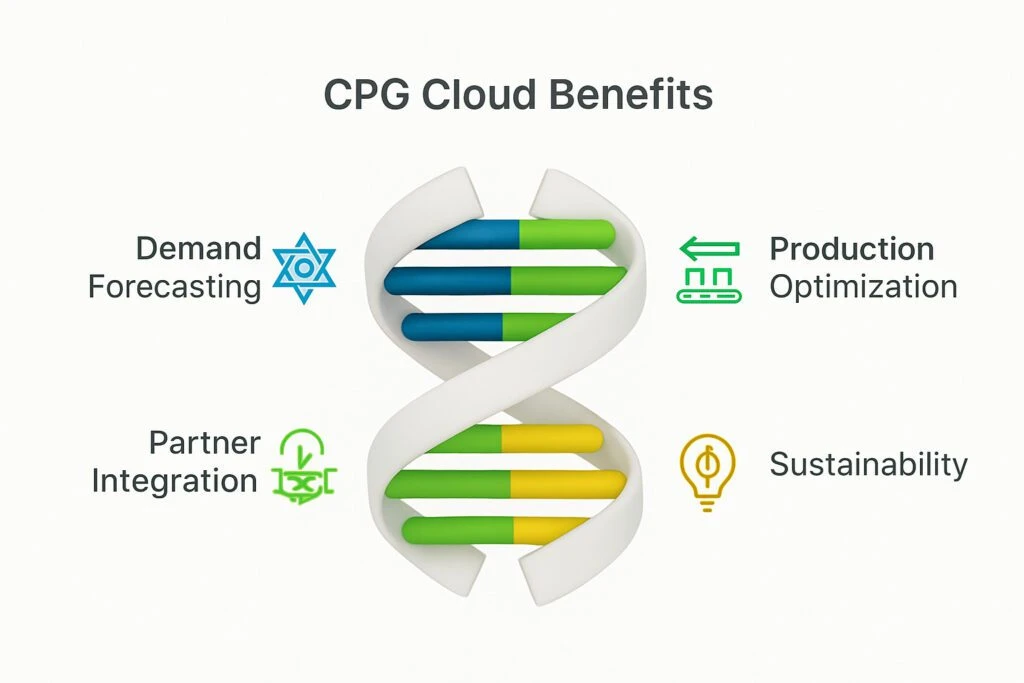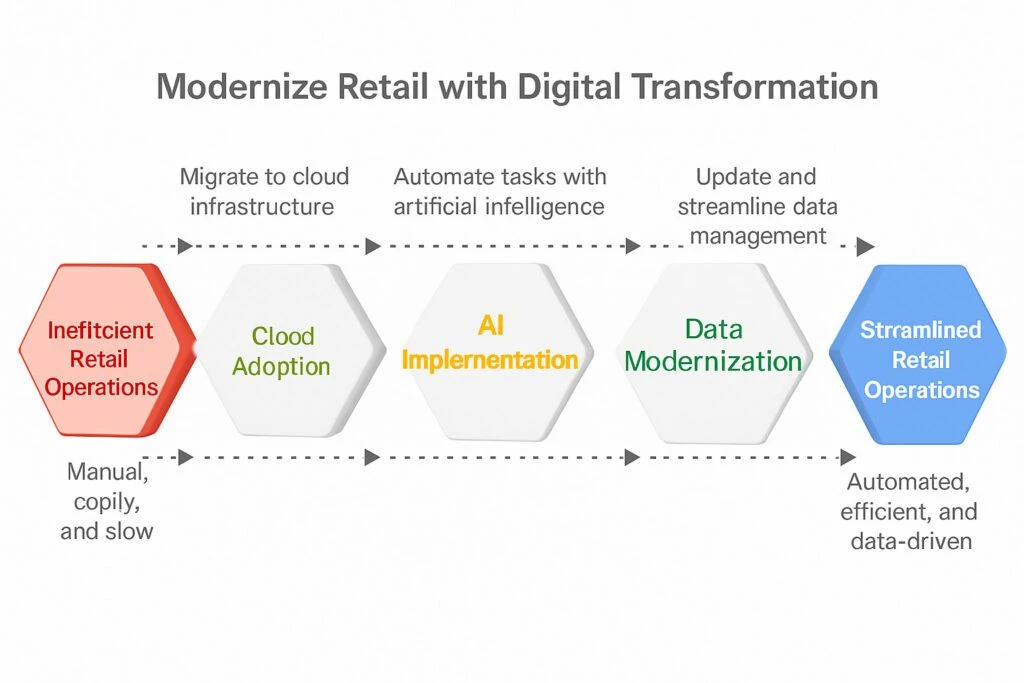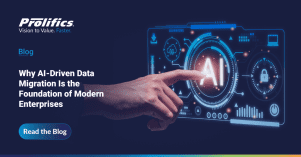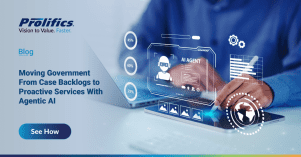Every successful digital transformation starts in the cloud. Cloud based logistics solutions play a critical role in today’s digital transformation journey. Cloud adoption gives businesses the scale, security, and real-time visibility they need to operate with agility. But the cloud isn’t the end goal; it’s the launchpad. Once that foundation is in place, AI takes over as the true value driver, turning unified data into sharper forecasts, smarter automation, and entirely new ways to serve customers. Together, cloud and AI move organizations from simply keeping up to leading the way in their industries.
The retail and consumer packaged goods (CPG) industries are under constant pressure. Shoppers demand convenience, speed, and personalized experiences, while supply chains face ongoing disruptions from inflation, shifting consumer demand, and geopolitical volatility. The solution many leaders are embracing is cloud-based logistics solutions.
A McKinsey report estimates that full adoption of cloud technologies could unlock trillions in EBITDA value by 2030, for retail and CPG firms, which translates into greater agility, resilience, and the ability to embed AI-driven logistics optimization into everyday operations. Cloud migration is no longer optional; it’s a competitive necessity.
– Source: McKinsey & Company
Challenges Driving Cloud Based Logistics Solutions in Retail & CPG
Despite years of investment, many supply chains remain constrained by outdated systems:
- Legacy infrastructure slows the pace of innovation and inflates costs.
- Demand volatility makes forecasting and replenishment difficult.
- Limited visibility across warehouses, suppliers, and carriers results in stockouts or excess inventory.
- Skills gaps prevent organizations from capturing the full benefits of automation and AI.
These realities highlight why retail companies are migrating to the cloud and why logistics cloud transformation has moved to the top of executive agendas.
Key Benefits of Cloud-Powered Logistics
1. Elastic Scale and Cost Efficiency
Cloud platforms allow organizations to scale resources up or down based on demand. During peak seasons, capacity expands seamlessly; in slower months, costs are minimized. This flexibility creates significant cost savings by moving the supply chain to the cloud, replacing heavy upfront capital investments with predictable operating costs.
2. Enhanced Supply Chain Visibility
Cloud-based supply chain solutions unify fragmented data and give decision-makers a real-time, end-to-end view. A supply chain control tower model consolidates orders, inventory, and shipments into a single dashboard, enabling faster, better decisions. The result is enhanced supply chain visibility across every node.
3. AI-Driven Optimization
Native AI services in the cloud improve demand forecasting, inventory allocation, and route planning. Retailers and CPG companies using AI-driven logistics optimization can automate replenishment, reduce manual errors, and ensure products reach the right shelf at the right time.
4. Security, Compliance, and Resilience
Cloud logistics platforms come with built-in encryption, governance, and disaster recovery. That means data is more secure, compliance requirements are met, and operations are more resilient to disruptions, a critical factor in highly regulated CPG supply chains.
5. Innovation and Future Readiness
Cloud unlocks access to emerging technologies like IoT, digital twins, and autonomous logistics. Companies adopting cloud-based logistics solutions now are better positioned to innovate, adapt, and thrive in the digital-first economy. To explore how these technologies are reshaping retail’s future, check out our blog on the Future of Retail.
Why Retail is Moving to Cloud Logistics
For retail, cloud is the foundation for omnichannel success. Cloud-native order management systems (OMS) can orchestrate inventory across physical stores, warehouses, and e-commerce platforms, ensuring customers always receive accurate delivery promises. This ability to connect demand and supply in real time is the cornerstone of an effective retail cloud strategy.
How CPG Companies Are Optimizing Logistics with Cloud
Consumer packaged goods companies are leveraging the cloud to address global supply chain complexity. With CPG cloud migration, leaders can:
- Improve demand forecasting with AI and advanced analytics.
- Optimize production and distribution planning across multiple regions.
- Integrate seamlessly with 3PLs, distributors, and retail partners.
- Build sustainable practices through better energy and resource optimization.

These steps reinforce the benefits of cloud for CPG logistics, including cost reduction, resilience, and faster response to market shifts.
Best Practices for Cloud Logistics Migration in Retail and CPG
- Define clear outcomes. Link cloud migration to measurable KPIs like forecast accuracy, perfect order rate, and logistics costs.
- Start with pilots. Begin with high-impact areas such as inventory visibility or transportation exception management.
- Modernize data architecture. Ensure data is clean, governed, and accessible to unlock supply chain digital transformation.
- Invest in workforce skills. Equip planners and logistics teams with cloud and AI training.
- Leverage trusted partners. Collaborate with technology providers and consulting firms experienced in retail and CPG migrations.
- Prioritize governance. Build strong security, compliance, and risk frameworks from the start.

Benefits at a Glance
- Scalable, cost-efficient infrastructure
- Enhanced supply chain visibility with real-time insights
- AI-driven logistics optimization for forecasting and routing
- Resilience and compliance built into operations
- Faster innovation with IoT, AI, and digital twins
FAQs
1. What is retail digital transformation?
It’s the process of using cloud, AI, and automation to modernize retail operations, from order management to customer engagement.
2. How can AI help logistics companies?
AI enables predictive demand planning, real-time route optimization, and automated replenishment, reducing costs and improving service.
3. What are best practices for cloud logistics migration in retail?
Start small with pilots, modernize your data, invest in skills, and align migration goals with overall business strategy.
Key Takeaways
Retail and CPG leaders can no longer afford to rely on outdated legacy systems for logistics. These older platforms often create bottlenecks, reduce visibility, and limit the ability to respond to sudden market changes. In contrast, cloud-powered logistics solutions provide a modern foundation for agility, resilience, and efficiency, capabilities that are no longer optional but essential to compete in today’s fast-moving markets.
By investing now, businesses can:
- Reduce operational costs through automated processes, optimized inventory management, and streamlined supply chains.
- Improve end-to-end visibility, giving leaders real-time insights into shipments, demand fluctuations, and customer needs.
- Strengthen resilience, ensuring that disruptions, whether from global supply chain shifts, labor shortages, or market volatility, can be managed with confidence.
- Scale quickly and efficiently, supporting future growth without the limitations of rigid legacy infrastructure.
The organizations that act decisively today will not only solve current challenges but also future-proof their operations. They’ll gain the ability to innovate faster, adapt to customer expectations, and seize new revenue opportunities in a highly competitive marketplace.
Ready to transform your supply chain? Start your cloud-powered logistics journey today with our experts.




